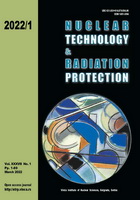
THE EFFICIENCY OF GAS-FILLED SURGE ARRESTERS IN THE ENVIRONMENT CONTAMINATED BY NON-IONIZING RADIATION OF FUSION REACTORS
Pages: 51-56
Authors: Nemanja M. Arandjelović, Dušan P. Nikezić, Uzahir R. Ramadani, Ivan M. Lazović, Nikola S. Mirkov, and Predrag V. OsmokrovićAbstract
The research presents an experiment with a model of an electronic generator for energy injection into the plasma of a fusion reactor. By recording a non-ionizing field in the vicinity of a fusion reactor, it was determined that this field has an extremely high growth rate. At the site of the maximum intensity of the field of non-ionizing radiation, commercial surge arresters with a flexible model of surge arresters were used for experimentation. It has been found that the commercial surge arresters have an efficiency of about 20 %. For the efficiency of the flexible model, it was found to be slightly less than 40 % (and to be achieved by the application of alpha particle radiation). Since neither of these efficiencies guarantee reliable operation of the gas-filled surge arrester, it was concluded that essential electronics in the vicinity of the fusion generator must be protected. However, since this protection can only be implemented in a fusion reactor, the fact remains that the environment of such a reactor is extremely contaminated with non-ionizing radiation. Commercial surge voltages are isolated for testing since the protection of electronic circuits from fast overvoltages is a critical point for the functioning of modern electronics.
Key words: electromagnetic environmental contamination, gas-filled surge arrester, fusion reactor, electromagnetic field
FULL PAPER IN PDF FORMAT (878 KB)
